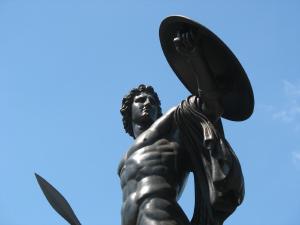Blog
Achilles’ Heel
6 July 2014
 Wikipedia
WikipediaAchilles, so the story goes was a mighty Greek warrior. When he was born, his mother dipped him in the river Styx, rendering him invulnerable except for the heel by which he was held. It was that vulnerable heel that was Achilles’ undoing, when Paris killed Achilles by shooting an arrow through the vulnerable heel. It’s a story of how the mighty can be destroyed by a seemingly minor flaw. A cautionary tale, if you will.
In science the same cautionary tale holds. Robust scientific theories are often so strongly supported by the evidence that they seem almost invulnerable, until some small unaccounted for phenomenon topples the reigning theory. The failure of Newtonian gravity to account for the precession of Mercury allowed general relativity to redefine space and time. The inability of Maxwell’s wave description of light to account for things like the photoelectric effect led to the quantum revolution. The unexpectedly low number of neutrinos coming from the Sun led to the discovery of neutrino mass.
We love to tell the story of fallen theories and their upstart replacements. It paints a picture of science as ever evolving and open to change. We don’t talk much of the vulnerable aspects of reigning scientific models. One of the criticisms of many fringe science proponents is that the “establishment” is unwilling to admit the weaknesses in their own models. Science should be self critical, they argue, and not dogmatic.
So in that spirit, this week begins a new series. We’ll look at the soft underbelly of standard cosmology and focus on five phenomena that modern astrophysics can’t fully explain.
Solar Corona – Hotter than we expect.
Dark Matter – Not for dwarf galaxies.
The Horizon Problem – Why so uniform?
Black Holes – A paradox wrapped in an enigma.
Supersymmetry – The perfect lie.
Each of these pose a challenge to modern astrophysics. Whether they will eventually succumb to standard models or whether they will overturn them is yet to be seen. We’ll look at problems without solutions, and questions without answers.
All this week, starting tomorrow.